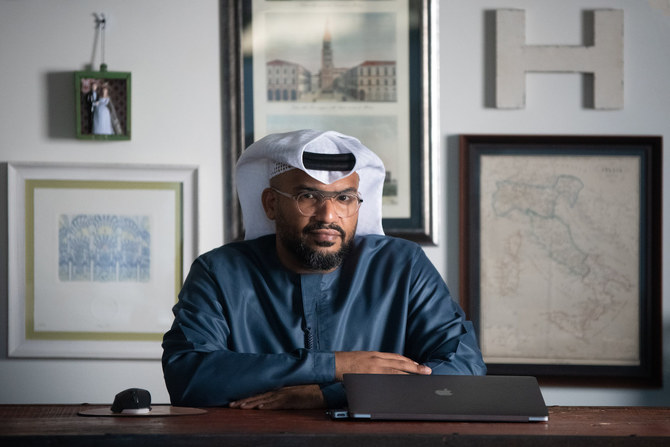DUBAI: Sometimes when we paradoxically find ourselves feeling out of place in a city or country we call home, we might be able to rekindle a sense of who we are through cultural means — whether it be food, music, or language.
For Emirati photographer and graphic designer Hussain Al-Moosawi, who went to study in Australia in 2005, returning in 2013, an effective way of warming up again to his urban surroundings was through architecture.
“I was overseas for eight years and for Dubai — or the UAE in general — that was a time when a huge real estate boom took place. I would come back once a year and not see new buildings, but a new cluster, a new neighborhood. With time, I could not make sense of what was happening and I didn’t feel like I belonged to it,” Al-Moosawi tells Arab News. “So, when I came back to my city, my place, (for good), it was alien to me, because my knowledge as a designer was not mature and the space was different. At a subconscious level, I wanted to document that, to feel connected again to the place. I had to renavigate the space by looking at small details. The typologist in me wants to understand that landscape; my quest is to make sense of space.”

“Bin Ghatti Vista” is from “Facades of the UAE.” (Supplied)
Al-Moosawi involved himself in a number of projects and the resulting images may come as a surprise to outsiders (perhaps some residents too), who have likely been exposed to the UAE as a glitzy, skyscraper-lined destination of movers and shakers. Nearly five years ago, he started photographing the uniquely colorful and patterned fences around construction sites in the UAE’s residential neighborhoods.
“It’s the state of being temporary that gives these fences the license to be whatever they want. To express freely. To be yellow or pink, or a bit of both. They teach us a lesson to be free,” he wrote of that project — “Under Construction” — in a statement.
Meanwhile, in 2019, Al-Moosawi dedicated time to capturing interior and exterior details of 40 places of worship — for a variety of faiths — across the UAE, all of which have been collected in a book, backed by the UAE’s Ministry of Culture and Youth, called “In Search of Spaces of Coexistence in the UAE.”

“Liwa Tower” is from “Facades of the UAE.” (Supplied)
“It took me six years, possibly, to reintegrate and I’m honored when I say that these projects did connect me back to the community,” he says.
For the past three years, Al-Moosawi has been following what he describes as his “life calling” — developing a pictorial database documenting the geometrical facades of buildings from the seven emirates: Classical and contemporary, high-rise and low-rise, flamboyant and brutalist.
What instantly stands out in “Facades of the UAE” — which can be viewed in a group exhibit at Dubai’s Gulf Photo Plus until January 30 — is the bedazzling and repetitive aesthetics of symmetry.

This picture is from “Under Construction.” (Supplied)
“There is a natural appreciation of symmetry to the human eye,” he says, comparing the facade’s visual appeal to that of a symmetrical human face. The varying facades are full of character with their earthy tones and glassy blues, not to mention the sheer variety of window shapes. Beyond their surface, though, the buildings also reflect the influence of a wide range of foreign design styles on the country since its unification in 1971.
“Many architects who were commissioned from the 1970s and 1980s came from the region, whether it was the Arab world or the Indian subcontinent,” Al-Moosawi explains. “But from the 1990s onwards, when the international firms came in, things got a bit messy in terms of how to build. I think it’s very important to mention that in those days usually the owner of the building would commission the architect or contractor directly. (That doesn’t happen nowadays) because real estate companies took over. Today, whatever you see around you, even towers, has been commissioned by real estate firms so you don’t have that individual touch.”

This picture is from “In Search of Spaces of Coexistence in the UAE.” (Supplied)
As you’d expect from his photographs’ meticulous composition, Al-Moosawi describes himself as systematic, trusting his instincts and clearly knowing what he’s seeking when clicking the button. He says that it can be a challenge driving around and finding the perfect building or location for his project. He has so far captured around 100 buildings.
“I love architectural details. You zoom out and you see windows, a portion of the buildings and then facades,” he says. “There are so many different kinds of zoom-ins, zoom-outs, and I think facades are a good crop to give people an impression about a city.”
Ultimately, Al-Moosawi hopes his repertoire of images will be featured in a series of books – classifying the facades according to era, location, style – that can be of use to architects for analytical purposes. “Architecture is very important. People care about it, but they need to be shown these things in a specific way, because sometimes without you showing it in such a way, they don’t pay attention,” he says. “The greatest achievement for me is when someone tells me, ‘Now I started noticing these buildings.’”












